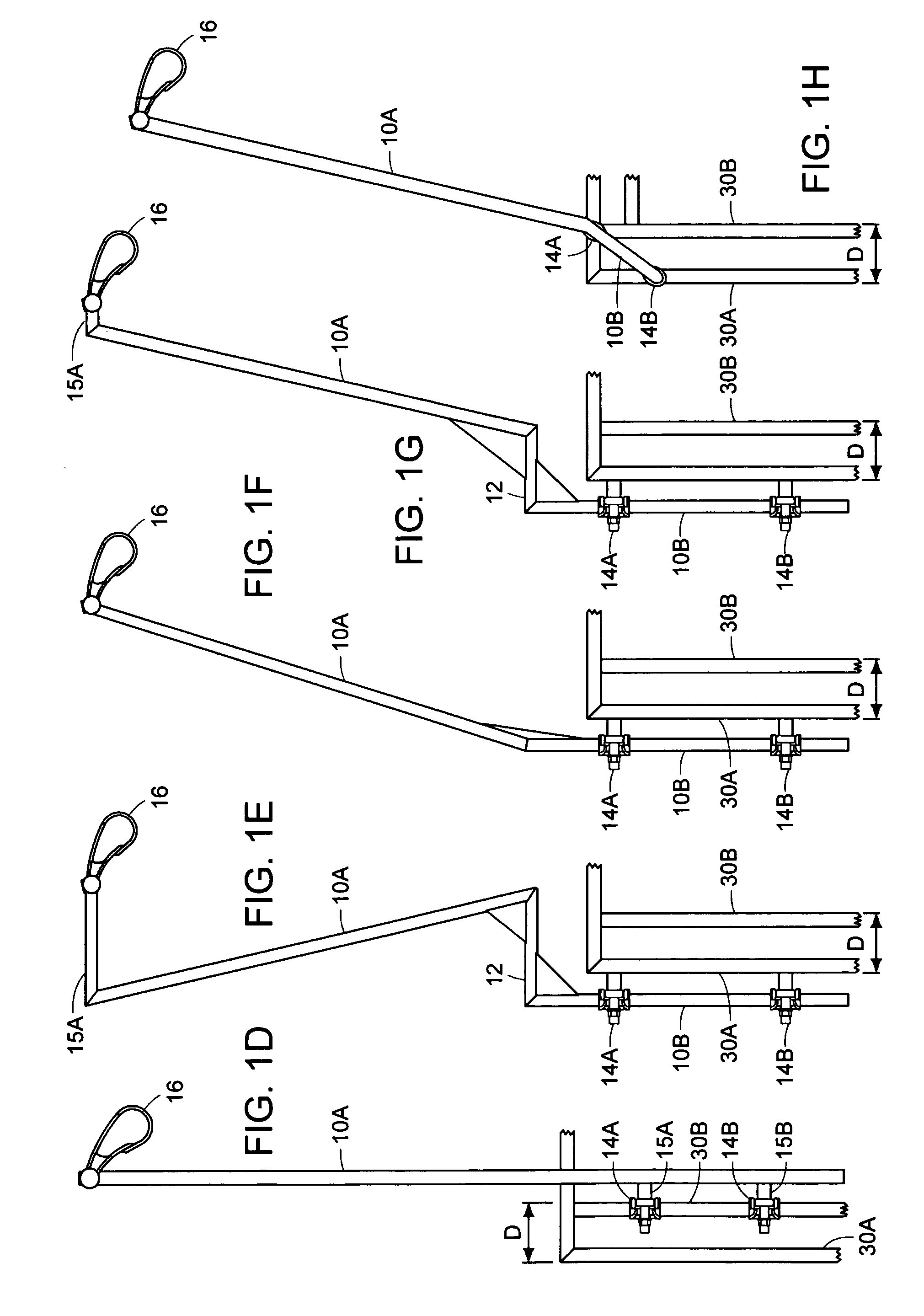Scaffold safety apparatus
a safety apparatus and scaffolding technology, applied in the direction of scaffold accessories, safety belts, building scaffolds, etc., can solve the problems of reducing the safety of workers, so as to increase the safety without minimizing productivity
- Summary
- Abstract
- Description
- Claims
- Application Information
AI Technical Summary
Benefits of technology
Problems solved by technology
Method used
Image
Examples
example 1
Construction of the Safety Scaffold Apparatus
[0057]The apparatus shown in FIG. 1A-C was constructed from two elongated members and a cross bar. These parts were welded together so that the elongated members were essentially parallel. One elongated member has a device for securing a safety line, namely a hook, and the other elongated member has an attachment for securing the safety device to the scaffold, namely two clamps. The elongated members and cross bar were reinforced with diagonal supports. The elongated member having the hook measures about 34 inches, and the elongated member having the clamps is about 32 inches in length. One clamp is positioned about 6 inches from the top of the elongated member, and the other clamp is positioned about 28 inches from the top of the same elongated member. The cross bar is approximately 11 inches in length. The elongated members and cross bar have a diameter of about 1⅝th inches, and are made from steel. The hook, which is about 4 inches in ...
example 2
Use of the Safety Scaffold Apparatus on a Frame & Brace Type Scaffold
[0058]A series of four apparatuses, constructed as described in Example 1, were installed on a tube and clamp type scaffold (Lynn-Lad Group, LTD. (Lynn, Mass.)). Once the ground level of the scaffold was set-up, each of the apparatuses was clamped to a vertical member of the scaffold, and positioned so that the elongated member having the hook was placed above the scaffold level to which the apparatus was clamped. The hook attached to the elongated member extended past the innermost portion of the scaffold railing underneath, which in this case was the inner railing of the tube and clamp system. The safety line was threaded through each hook and double looped and reattached to itself. The line was tightened and the ends of the line were held in place using a come-a-long device. A person, having a harness and lanyard, then engaged the lanyard hook to the safety line. The person then proceeded to attach the next scaf...
example 3
Use of the Safety Scaffold Apparatus on a Cup Lock Type Scaffold
[0059]A series of four apparatuses, constructed in Example 1, were installed on a cup lock type scaffold (Lynn-Lad Group, LTD. (Lynn, Mass.)). Once the ground level of the scaffold was set-up, each of the apparatuses was clamped to a vertical member of the scaffold, and positioned so that the elongated member having the hook was placed above the scaffold level to which the apparatus was clamped. The cup lock type scaffold does not have a double scaffold railing; rather, it has a single vertical member at each support. Hence, the hook attached to the elongated member extended past the single vertical scaffold railing underneath. The safety line was threaded through each hook and double looped. The line was tightened and secured using a come-a-long device. A person, having a harness and lanyard, then engaged the lanyard hook to the safety line. The person then proceeded to attach the next scaffold level and install the ve...
PUM
 Login to View More
Login to View More Abstract
Description
Claims
Application Information
 Login to View More
Login to View More - R&D
- Intellectual Property
- Life Sciences
- Materials
- Tech Scout
- Unparalleled Data Quality
- Higher Quality Content
- 60% Fewer Hallucinations
Browse by: Latest US Patents, China's latest patents, Technical Efficacy Thesaurus, Application Domain, Technology Topic, Popular Technical Reports.
© 2025 PatSnap. All rights reserved.Legal|Privacy policy|Modern Slavery Act Transparency Statement|Sitemap|About US| Contact US: help@patsnap.com



